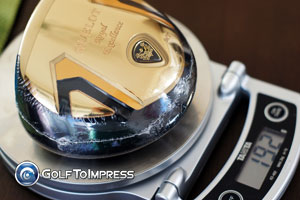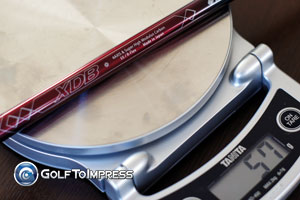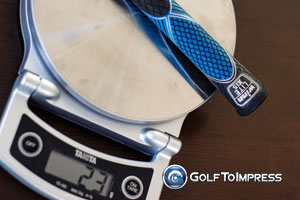So with the very promising performance of the Quelot Royal Excellence drivers in my earlier testing, I decided to build myself an ultra light performance driver using the Quelot. Though it’s hard to measure actual performance gain of a non conforming head, especially for average swing speed players like myself, I still decided to go for the non conforming Hi-Cor Alpha Spec model. If anything its psychological using a non conforming model.
The Quelot Gold Alpha Spec uses the SP700 Titanium face and features 0.87 COR. SP700 is said to be more springy at impact than the cheaper and more typical 6-4 titanium so it will be interesting to see if there is any feel or performance difference from the conforming models I tested earlier including the 6-4 ti Quelot Silver.
 There were several things to consider when building this driver. These days drivers lengths are getting longer and longer with many at 46″ or even 46.5 and 46.75″ all for the sake of gaining some head speed and more distance. If I remember correctly an extra inch in length adds approximately 2 m/s or 4.5mph to ones swing so going from a 45″ driver to a 46.5″ driver theoretically would add 3m/s or nearly 7mph in swing speed. The catch is, the longer the driver is in length the hard it is to hit the sweet spot consistently on that driver. A shorter driver can provide more consistency and accuracy resulting in more net distance. A longer driver becomes harder to square up at impact resulting in lost control and lower smash factor which leads to ultimately less distance.
There were several things to consider when building this driver. These days drivers lengths are getting longer and longer with many at 46″ or even 46.5 and 46.75″ all for the sake of gaining some head speed and more distance. If I remember correctly an extra inch in length adds approximately 2 m/s or 4.5mph to ones swing so going from a 45″ driver to a 46.5″ driver theoretically would add 3m/s or nearly 7mph in swing speed. The catch is, the longer the driver is in length the hard it is to hit the sweet spot consistently on that driver. A shorter driver can provide more consistency and accuracy resulting in more net distance. A longer driver becomes harder to square up at impact resulting in lost control and lower smash factor which leads to ultimately less distance.
Its all about finding the right length for each individual. Surely there are those who have no problems hitting a 46″ driver and reap the benefits of the extra speed and distance. Then there are those who simply need a short driver to keep it in the fairway thus use lengths between 44 and 45″ or even shorter. I typically play a driver around 44.5″ and can handle a 45″ and maybe 45.25″ driver and still remain consistent. As the driver gets longer than that, I lose distance as my smash factor decreases and I begin to go towards the right as I become late squaring the head. The Quelot Gold A-Spec is a very light head at 188g stock spec. It is meant to be built at 46″ or longer lengths in order to keep an acceptable swing weight. I knew this would be a problem when I built this club so I asked Geotech to pick out the heaviest head they could find and they sent me a 192g head (which they told me is very rare as its usually plus or minus 2g at most). This helped a bit as for every 2g that the head weight increases, swing weight goes up 1 point. Still at this length if I wanted to build a driver at 44.5″ the swing weight would be unacceptably low. Every half an inch equals 3 swing weight points so if at stock spec, the Gold Alpha at 46″ is an approximate C8-D0, then dropping down to 44.5″ would drop the swing weight 9 points or to around C0! So in the end I decided the target finished length would be 45.00″ though there was still some work to do to get to an acceptable D0 swing weight which is what I was hoping for.
 I decided in building this driver that it would also be a chance to try out the new XDB High Modulus shafts. I wanted to use the 90t XDB65 model but they were heavier than what I wanted (though that would have helped gain a touch of swing weight) and the softest flex was Stiff/Regular. I ended up going with the XDB55 Regular which is the 50t model. The raw uncut weight of the XDB55 was 57g. Working with lighter shafts also make reaching swing weight more challenging. The weight of a shaft also has an effect on swing weight. Every 8 to 9g equals 1 swing weight point so a heavier shaft helps increase swing weight. Once the XDB55 is cut to length, its weight will become even lighter. Just some info on the XDB55, unlike the XDB65 which uses a 4 Axis butt with 90t mid section and 50t tip section, the XDB55 has a 4 axis weave with a 50t mid and tip section. I think I’ve explained what carbon grading is many times already on the blog but just in case for those first time readers, I will copy and paste what I wrote before.
I decided in building this driver that it would also be a chance to try out the new XDB High Modulus shafts. I wanted to use the 90t XDB65 model but they were heavier than what I wanted (though that would have helped gain a touch of swing weight) and the softest flex was Stiff/Regular. I ended up going with the XDB55 Regular which is the 50t model. The raw uncut weight of the XDB55 was 57g. Working with lighter shafts also make reaching swing weight more challenging. The weight of a shaft also has an effect on swing weight. Every 8 to 9g equals 1 swing weight point so a heavier shaft helps increase swing weight. Once the XDB55 is cut to length, its weight will become even lighter. Just some info on the XDB55, unlike the XDB65 which uses a 4 Axis butt with 90t mid section and 50t tip section, the XDB55 has a 4 axis weave with a 50t mid and tip section. I think I’ve explained what carbon grading is many times already on the blog but just in case for those first time readers, I will copy and paste what I wrote before.
Shafts are created with carbon fibers weaved together, and these fibers are measured by their modulus of elasticity in tension. Typical golf shafts are around 24t or 30t, the measurement of tensile strength. These lower grade shafts are more flexible and because of this the shaft is slow to regain its original shape on the downswing creating inconsistent impact where a player must rely heavily on timing due to the flexibility of the shaft. As the tensile strength increases, the carbon weaves are more dense, more rigid and return more quickly to their original shape. The flex and rebound of the shaft becomes more predictable equaling more consistent shots and much tighter dispersion. The higher tensile ratings ratings in golf shafts are also related to the higher grades containing more glass and metal particles which are more rigid and lower grades containing more flexible rubber particles.
 Finally the last part of the driver build that can have a large impact on the finished swing weight is the grip. Grips these days average around 48-52g and a lighter weight grip helps increase swing weight. Think of a seesaw where the less weight you put on one end the heavier the other end feels and gets and that side of the seesaw goes down. The same goes for the golf club as the grip side decreases by 4g you gain approximate 1 swing weight point (and the opposite if the grip weight increases by 4g). I previously resorted to Golf Pride DDM Light’s which were around 37-38g and always helped me gain back approximately 3 points which in this case was not enough. I decided to find the lightest grip I could on the market which is the Winn Lite Xi5. Personally I don’t use Winn Grips and I don’t necessarily like the way they look of feel however nothing is as light as the Xi5’s spec’ed 25g. Thanks to Winn Japan, they actually sent me a 23g one which certainly helped as it is 25-27g lighter than the average grip.
Finally the last part of the driver build that can have a large impact on the finished swing weight is the grip. Grips these days average around 48-52g and a lighter weight grip helps increase swing weight. Think of a seesaw where the less weight you put on one end the heavier the other end feels and gets and that side of the seesaw goes down. The same goes for the golf club as the grip side decreases by 4g you gain approximate 1 swing weight point (and the opposite if the grip weight increases by 4g). I previously resorted to Golf Pride DDM Light’s which were around 37-38g and always helped me gain back approximately 3 points which in this case was not enough. I decided to find the lightest grip I could on the market which is the Winn Lite Xi5. Personally I don’t use Winn Grips and I don’t necessarily like the way they look of feel however nothing is as light as the Xi5’s spec’ed 25g. Thanks to Winn Japan, they actually sent me a 23g one which certainly helped as it is 25-27g lighter than the average grip.
Butt trimming the shaft to length dropped about 4g off the shaft weight and dry installing it at 45″ and taking a swing weight measure with the grip and ferrule and the measurement came out to approximately C8.8. I had 2g of tungsten powder mixed into the epoxy and installed the head with the nice dual gold band black ferrule. Once it dried the swing weight was checked again and it was right on D0.
I always have the CPM of every club I use checked as a reference and idea of how “stiff” that club might be. CPM is only one tell tale characteristic of a clubs perceived “stiffness”. It does not tell you how a shaft will perform, feel or even how that stiffness is distributed within a club/shaft. It is however a useful reference for general comparison as there is no standards in flex and CPM’s can wildly fluctuate from brand to brand. There are also many factors affecting CPM measurements like, machine used, clamp size, measured with grip without grip, head weight, shaft balance point etc, will all effect CPM. Measured as a fully finished club at 45″ with a 7″ clamp, the Quelot Alpha Spec with XDB55 Regular came out at a soft 227CPM. I will be frank and say this concerns me especially since a lighter head weight should actually increase CPM meaning that the XDB55, at least CPM WISE, is on the soft side. I won’t jump to conclusions and say this shaft is too soft but for the moment the CPM of the club is lower than what I hoped (my Crazy LY-01 R2 Flex finished driver was around 242 CPM if I remember correctly). The bottom line will be real world testing and how the club performs. For the moment I have a nice looking non conforming 272g ultra lightweight driver that I hope will provide good distance for an average swing speed and average level player like myself. Now I just need it to warm up a bit so I can get out there and hit this driver for part 2.


Hey it’s 26 degrees C over here in Cali today. You should spray that driver all over the course over here! LOL
I remember using a rented, non-conform XXio driver a few years ago. It was light, totally forgiving and I was busting it to 330 yard without even thinking and the people in my group who were ordinary Japanese people were absolutely astounded that I was poking it that far, and I told them because it was non-conforming, I was getting around 20 plus more yard out of it. It was like a whip though, which was weird feeling, but it went so damned straight and so damned far. I didn’t know that when it’s non-conforming it would go that much farther.
So my question is: how much COR does the Quelot have?
Hi Geet, the old XXIO Hi Cor’s were the bomb! The soft shaft definitely gives distance as well.
I noted the COR in the first line of the second paragraph, 0.87COR, not quite as high as the Kamui’s 0.88 but still pretty good. The old Yamaha Hi Cor’s were 0.90!!
Aha! Kewl. I was so in love with the pics the numbers and text in your writing escaped me LOL Thanks
Have you hit this at the course yet? I wanted to know what you think of the XDB shaft.